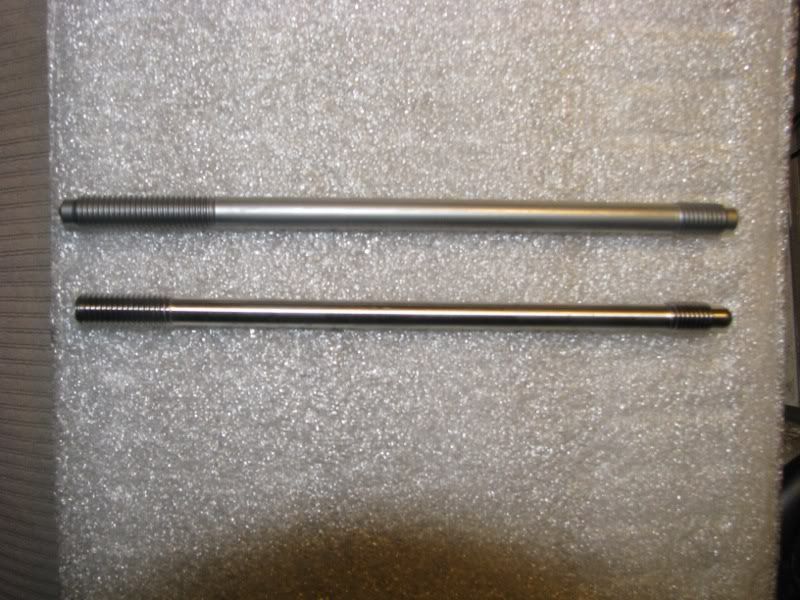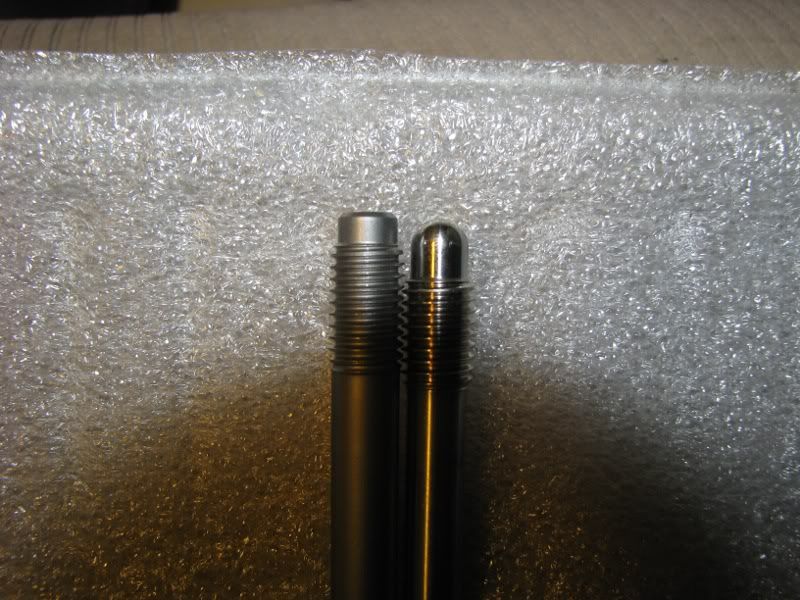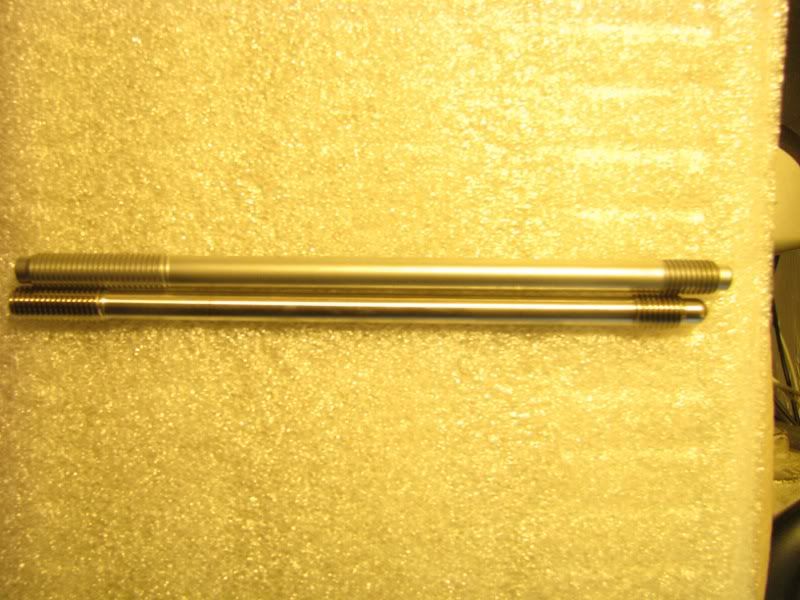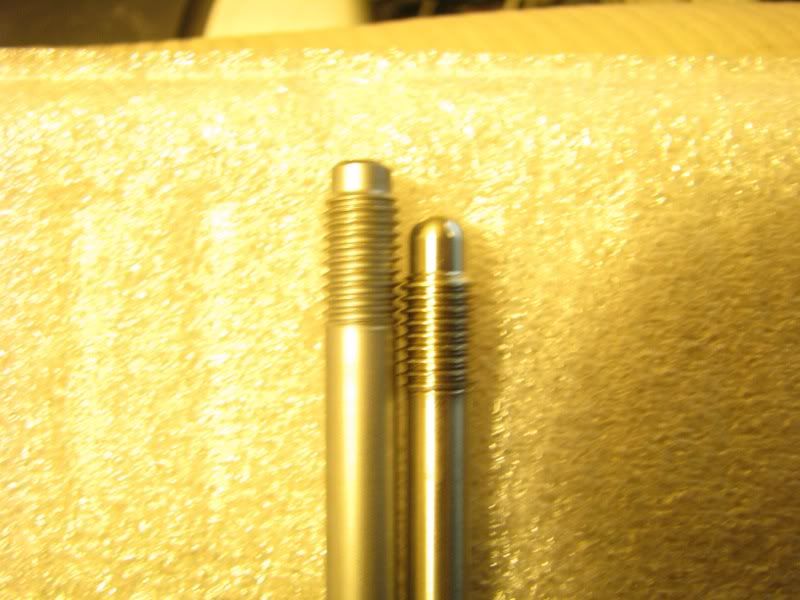APR headstud install issue
#16
I have yet to contact ARP about the return of these studs yet, but I wanted to post some side by side comparison pictures of the ARP studs and the EVOMS studs showing the definitive length issue at hand here.
Side by side comparison, with the case end threads lined up to each other on the left side. Evo stud on top. Note the substantial increase in case thread on the Evo stud, as well as the bull nose that goes INTO the case to provide a dead stop for the stud at the bottom of the stud register in the case. ARP tried telling me the bull nose is supposed out go out. For what? To make it easier to put the nut on the end of the studs?!?!?! If you cannot manage to get the nut properly threaded onto the end of the stud w/o a bull nose you certainly don't belong assembling one of these motors and need to put the tools down

Close up of the nut end thread of the two studs as aligned above(case threads at equal depths). Evo stud is to the left, and the "bull nose" on the top of the Evo stud actually contains a shallow hex cavity for installation/removal of the stud.

Side by side comparison of the two studs as they would sit bottomed in the case register. That's how these type of studs are supposed to be installed, not locktighted and set to a specific height like OEM studs are.

And now a close up of the nut end thread of the studs as aligned above(to register bottom). The lack of available thread is plainly visible in this photo

With these pictures I cannot see how ARP can have a foothold in saying they were designed properly for the application, and not accept the return. Time will tell when I place the call/emails tomorrow.
Huge thanks to Ian @ EVOMS for holding the last set of studs they had in stock for my customer until he bought them Now I just have to get my hands on ~10 more OEM headnuts and I should be back on track with this build.
Now I just have to get my hands on ~10 more OEM headnuts and I should be back on track with this build.
Side by side comparison, with the case end threads lined up to each other on the left side. Evo stud on top. Note the substantial increase in case thread on the Evo stud, as well as the bull nose that goes INTO the case to provide a dead stop for the stud at the bottom of the stud register in the case. ARP tried telling me the bull nose is supposed out go out. For what? To make it easier to put the nut on the end of the studs?!?!?! If you cannot manage to get the nut properly threaded onto the end of the stud w/o a bull nose you certainly don't belong assembling one of these motors and need to put the tools down


Close up of the nut end thread of the two studs as aligned above(case threads at equal depths). Evo stud is to the left, and the "bull nose" on the top of the Evo stud actually contains a shallow hex cavity for installation/removal of the stud.

Side by side comparison of the two studs as they would sit bottomed in the case register. That's how these type of studs are supposed to be installed, not locktighted and set to a specific height like OEM studs are.

And now a close up of the nut end thread of the studs as aligned above(to register bottom). The lack of available thread is plainly visible in this photo

With these pictures I cannot see how ARP can have a foothold in saying they were designed properly for the application, and not accept the return. Time will tell when I place the call/emails tomorrow.
Huge thanks to Ian @ EVOMS for holding the last set of studs they had in stock for my customer until he bought them
 Now I just have to get my hands on ~10 more OEM headnuts and I should be back on track with this build.
Now I just have to get my hands on ~10 more OEM headnuts and I should be back on track with this build.
#17
I should have 10 stock head nuts laying around.. My question is why use stock? The studs do not come with hardened washers to place on first? The large face of the stock nut creates a lot of friction and that will change your clamp up force to fastener torque. The harden washer spreads the load and the nuts provides the clamp up. Combining the two is good for saving money and removing one step on assembling.
#18
I should have 10 stock head nuts laying around.. My question is why use stock? The studs do not come with hardened washers to place on first? The large face of the stock nut creates a lot of friction and that will change your clamp up force to fastener torque. The harden washer spreads the load and the nuts provides the clamp up. Combining the two is good for saving money and removing one step on assembling.
Correct, the Evo studs did not come with any washers/nuts. The Evo studs actually came with zero paperwork as well, no specific torque procedure or torque specification. I've read somewhere they had a specific torque procedure for the stock nuts, however the answer is a phone call away to Ian so I'll be giving him a shout shortly.
And I do agree completely with your statement there. I could use the ARP nuts and washers from the kit here, but then I'm stuck with ~$600 of fasteners I cannot return or use.
New nuts were ordered from Suncoast this afternoon so I'll at the very least have the OEM's on standby if nothing else.
Thread
Thread Starter
Forum
Replies
Last Post
ECS Tuning - VW
VW Vendor Classifieds
0
08-21-2015 10:11 AM






 Thank you for the info
Thank you for the info

